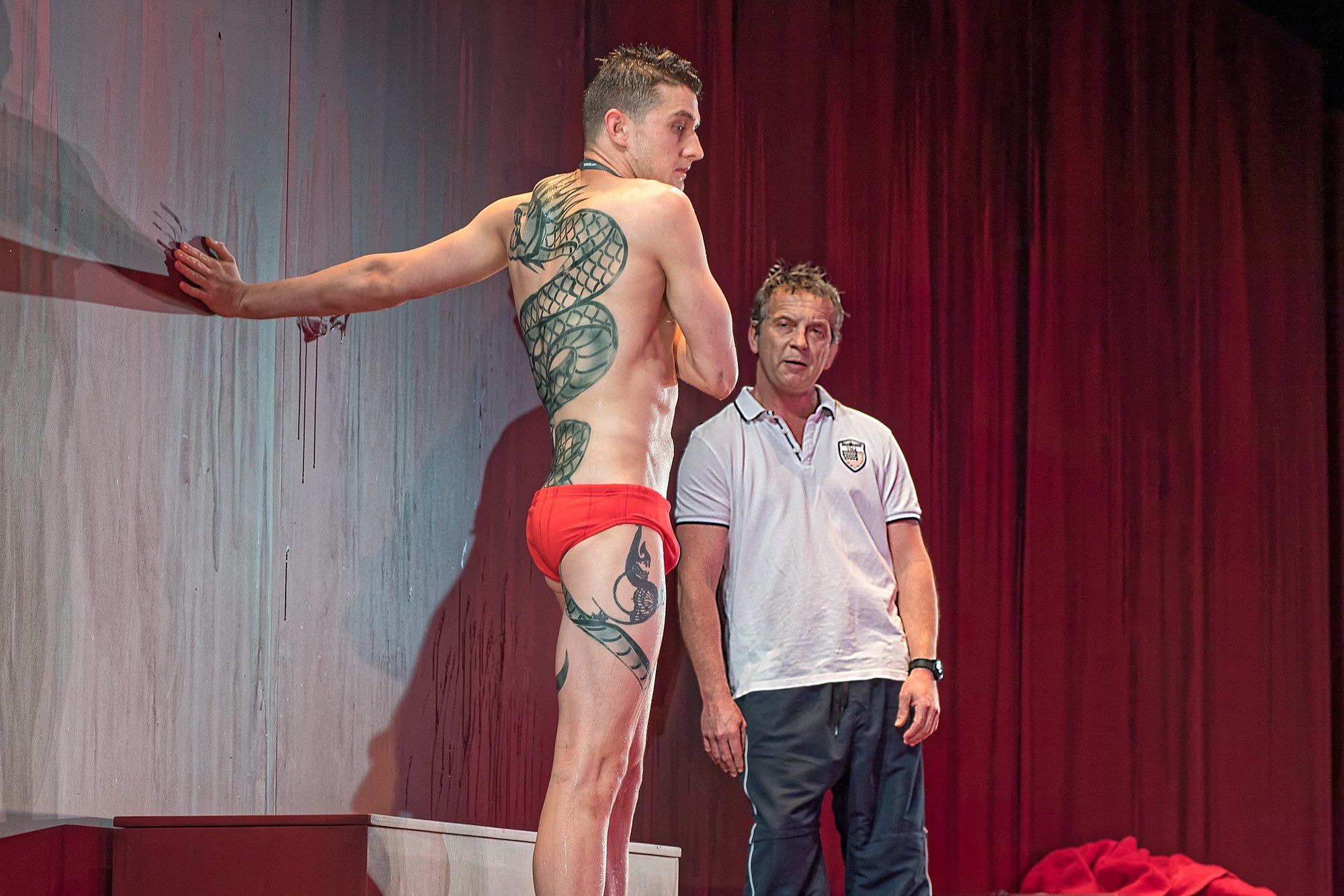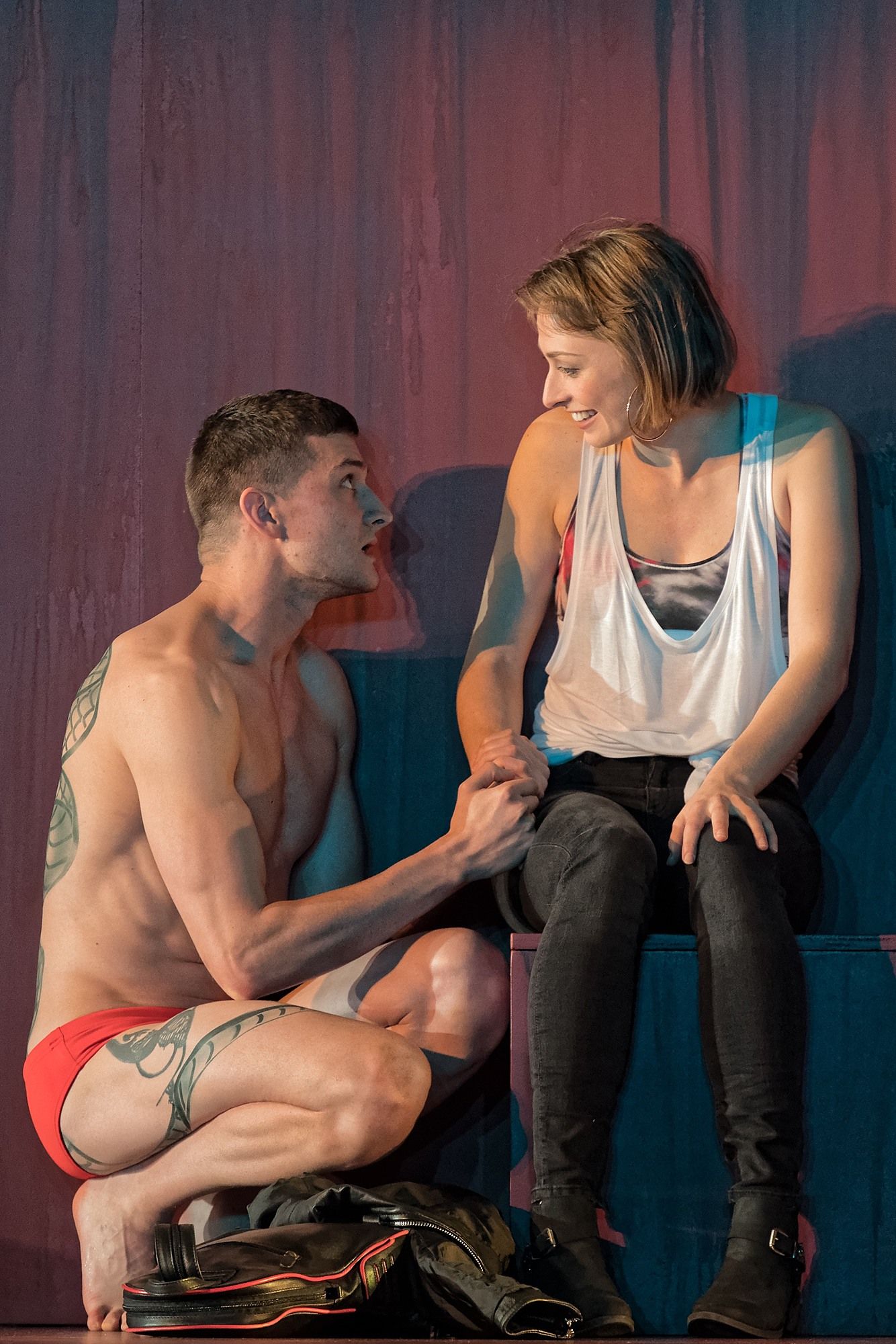Tumble turn: A Review of Red Speedo
Director Ben Henson's bold Auckland Theatre Company mainstage debut opened last Thursday. Sam Brooks reviews.
Director Ben Henson's mainstage debut with Auckland Theatre Company – a bold production of Lucas Hnath's Red Speedo – opened last Thursday. Sam Brooks reviews.
I’m tired of winning.
One of the last lines in Lucas Hnath’s Red Speedo is also one of its biggest gut-punches, in a play that hits you right across the face with every misguided thing its protagonist does. The protagonist and owner of that line is Ray, a star swimmer who has a chance to qualify for the Olympics. He’s dim, sweet-hearted and ultimately hemmed in by the people and the system around him. By the time he says that he’s tired of winning, we’ve spent the entire play watching him lose and lose over again. It’s the cruelest question the play sets up: if this is winning, what the hell does losing look like?
Director Ben Henson makes the journey towards answering this question as visual as possible. The entire action of the play takes place in the locker rooms or at the side of a pool, which set designer John Parker re-imagines as a kind of red cliff that the characters could fall off at any point. Meanwhile slowly swirling water is projected above and below the actors, which, given set’s the red tint, makes it look less like water and more like blood. It’s foreboding as all hell and from the second the play starts we know that things are going to go wrong.
One of the strongest things about Hnath’s writing is his willingness to play around in the grey shades of these characters in this specific milieu – the world of competitive sports. Despite each character at some point in the play doing something for their own self-serving purposes, they’re never defined only by their bad actions. When Ray proves incredibly childish and short-sighted, potentially screwing his brother out of a job to appease his ex-girlfriend Lydia, we nonetheless empathise with his motivations, making it all the much more excruciating. When the play comes to its exhausted conclusion, there’s no clear winner or loser. Everybody has just been trying to make it to the end of the same unforgiving game; exhausted, bloody, and not sure if the game was even worth playing.
It’s these moments which reach the high bar the script sets for Carter and make for a stunning mainstage debut.
The performers dig into these complexities superbly. Ryan Carter does incredibly layered work as Ray, having to balance the sheer weight that’s on the character’s shoulders, with some of the more comic beats in the play. One of the biggest laughs in the show is the reveal of Ray’s tattoo; as grotesquely real a bad tattoo as I’ve ever seen. It speaks volumes of Carter’s performance that he convinces us that the Ray we’re watching would absolutely get that tattoo. As the play develops, we see more and more Ray’s glazed disconnect from the world; he doesn’t know how to engage with anything except his dreams. Carter pulls layers upon layers out of Ray: the way he physicalises his stress; the way he goes into himself when he has to confront his own self-denial and flailing uselessness. It’s these moments which reach the high bar the script sets for him and make for a stunning mainstage debut.
Ray’s older brother Peter is a two-bit lawyer who is smart enough to do the low-level scheming required of him, but not smart enough to figure anything out ahead of time. He’s the kind of high-voltage character that Hnath could have plucked from David Mamet’s Glengarry Glen Ross. As Peter, Wesley Dowdell does very fine work. Dowdell’s performance shows us the constant frustration that exists in the gap between his scheming and his blindspots. When he’s confronted with his brother’s betrayals, but was unable to see them coming, he can only stamp like a little child.
Chelsie Preston-Crayford is flat-out great as Ray’s ex-girlfriend Lydia, and in a play full of masculine energy and testosterone, she’s a breath of fresh air. There’s a no-bullshit clarity to Lydia, and Preston-Crayford’s performance is spiky and funny enough to shake the play up in a way it really needs at the midway point. As Ray’s coach, Scott Wills has the least complex character to play, there’s less to dive into, but he lends the character a softness that introduces a fascinating element to the production; a character who seems to care about Ray regardless of what Ray can do for him.
As Red Speedo hurtles towards its ending, each one of Ray’s (and subsequently Peter’s) wayward dreams are broken until all they both can do is literally, physically, flail against the world around them. Things aren’t fair for Ray, or for anybody, and as he realises that, he breaks.
Rachel Marlow’s lighting design does an especially great job of shifting momentum and tone with loud, sudden transitions and a subtly degrading red palette.
Not everything about this production works – some AV choices towards the end are visually stunning but disrupt the momentum the play has very carefully built up. But Henson’s production of Red Speedo does exactly what it needs to do. It takes a great, complex script, layers it with engaging, charismatic performances and a winning design. Rachel Marlow’s lighting design does an especially great job of shifting momentum and tone with loud, sudden transitions and a subtly degrading red palette.
It’s a daunting script that could be sunk by a weak vision or a poor design, and Henson keeps the play moving sharply, believably, to its tragicomic conclusion: two men too exhausted to fight anymore. It’s what losing looks like.
Red Speedo runs from October 31 – November 15 at ASB Waterfront Theatre. Tickets available here.



